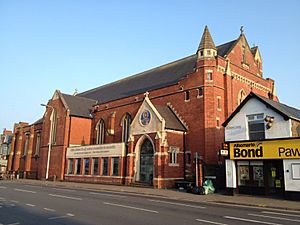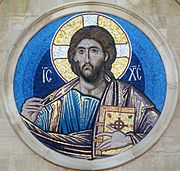St Martin's Church, Roath facts for kids
Quick facts for kids St Martin's Church |
|
|---|---|
 |
|
| 51°29′34″N 3°10′15″W / 51.4927°N 3.1708°W | |
| Denomination | Church in Wales |
| Churchmanship | Anglo-Catholic |
| Website | [1] |
| History | |
| Status | Active |
| Founded | 1886 |
| Dedication | St Martin of Tours |
| Consecrated | 20 October 1901 |
| Architecture | |
| Functional status | Parish church |
| Architect(s) | F. R. Kempson |
| Style | Neo-Gothic |
| Groundbreaking | 16 December 1899 |
| Completed | 1901 |
| Specifications | |
| Bells | 1 |
| Administration | |
| Parish | Roath St Martin |
| Deanery | Roath St Martin |
| Diocese | Llandaff |
St Martin's Church is a special Anglican church. It is located on Albany Road in Roath, a part of Cardiff, Wales.
Contents
The Story of St Martin's Church
Early Days and New Beginnings
St Martin's Church was first built in 1886. It started as a "tin tabernacle." This was a simple church made from corrugated iron. It was built to serve the growing area of Roath. The church you see today replaced the tin tabernacle in 1901. In 1903, St Martin's became its own separate church area, called a parish.
The church had a special small chapel called the "lady chapel." A Belgian artist decorated this chapel. He was a refugee during the First World War. He decorated it to thank the church members for their kindness.
Rebuilding After the War
Sadly, the inside of the church was completely destroyed. This happened in February 1941. An incendiary bomb hit the church during the war. An incendiary bomb is a type of bomb that causes fires.
After the bombing, church services continued. They were held in the choir vestry. This was a part of the church that survived. Services also took place in the nearby St Cyprian's church. The main church building was fully repaired and restored by 1955.
During the restoration, some changes were made. The fancy designs around the windows, called "tracery," were replaced. Simpler windows, known as "lancet windows," were put in. These new windows let in more light.
Modern Additions and Art
In 2011, a new covered walkway was added. This walkway is called a "cloister." It faces the street. Archbishop Barry Morgan officially opened it.
In 2013, a beautiful mosaic was installed. It is above the main entrance of the church. This mosaic shows Christ Pantocrator. This means "Christ, Ruler of All." It was created by an artist named Aidan Hart. Rowan Williams, who used to be the Archbishop of Canterbury, blessed the mosaic.


